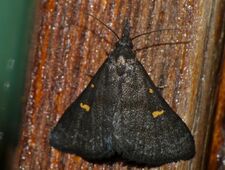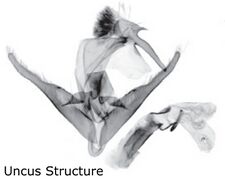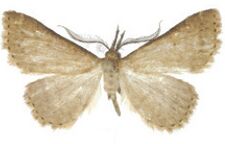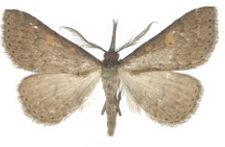Biology:Naarda
| Naarda | |
|---|---|

| |
| Naarda xanthonephra | |
| Scientific classification | |
| Domain: | Eukaryota |
| Kingdom: | Animalia |
| Phylum: | Arthropoda |
| Class: | Insecta |
| Order: | Lepidoptera |
| Superfamily: | Noctuoidea |
| Family: | Erebidae |
| Subfamily: | Herminiinae |
| Genus: | Naarda Walker, 1866 |
| Type species | |
| Naarda bisignata Walker, 1866
| |
| Species | |
|
Multiple, see text. | |
| Synonyms | |
| |

Naarda is a large genus of erebid moths currently encompassing 108 species.[1][2] Initially identified by Francis Walker in 1866,[3] it is in the family Erebidae.[4] Somewhat ruddy in appearance, this genus is distinguishable for its generally slender thorax and abdomen, and straight, porrect labial palpi. Most species are a light tan color, but shading can reach as deep as a charcoal, with muddy yellow, conspicuous reniform, orbicular stigmata featured on the forewings, sometimes reflected bilaterally superior. (Though these may be significantly more minute and successively annular.)
Physical features
The wingspan is between 19-22mm, dependent on the species.[5]
The rami of the antenna are, at the maximum of its width, 9-10 times longer than the axis of the antenna, and the apical segments lack the rami.
Aside from the elongated and easily recognizable porrect labial palpi of both sexes, (which are usually 5 times as long as the diameter of the eye, with the tertiary segment comparatively longer), and the relatively broad forewings with straight and even costa, substantial dissimilarity is present in the male sex.[6]
Male
The most prominent autapomorphy is the uncus structure, which resembles the head of a long-billed bird.[7] The uncus has a large, rounded subbasal dorsal bulb bearing a small, acute frontal spine and a large group of long hairs standing apart, (in the likeness of a forelock), and a long, straight, atypically dilated rounded distal section.[7][3]
Other recurrent traits of the clasping apparatus across the entirety of the Naarda genus include the substantially broad tegumen; the well-developed and stout transtilla; and the variably broad, generally triangular valvae. The entire structure resembles a flying bird.[7][8]
The phallus is short, straight, and thick; the vesica is inflated and basally broad. In most species, the ductus ejaculatoris is directed forward in the axis of the phallus. The cornutus is variably large, and its texture resembles that of a sponge cake.[7]
Range
Of the 108 known species, virtually the entirety have been discovered in Asia, Southeast Asia, and Africa, but a handful are in the northern Australia region.[7]
Countries where Naarda genus has been documented:
Species list
References
- ↑ "Naarda (genus)". BayScience Foundation, Inc.. 2004–2008. http://zipcodezoo.com/Key/Animalia/Naarda_Genus.asp. Retrieved 2008-08-20.
- ↑ "Gynaephila". Hudson Institute of Mineralogy. https://www.mindat.org/taxon-1779721.html.
- ↑ 3.0 3.1 3.2 3.3 Tóth, Balázs (23 February 2018). "New data on the taxonomy, morphology and distribution of Naarda ineffectalis (Walker, 1859) (Lepidoptera, Erebidae, Hypeninae)". Nota Lepidopterologica 41 (1): 99–106. doi:10.3897/nl.41.21584. https://zenodo.org/record/1222601/files/NL_article_21584.pdf.
- ↑ Savela, Markku (February 24, 2012). "Naarda Walker, 1866". https://www.nic.funet.fi/pub/sci/bio/life/insecta/lepidoptera/ditrysia/noctuoidea/erebidae/herminiinae/naarda/. Retrieved February 4, 2020.
- ↑ 5.0 5.1 5.2 Tóth, Balázs; Ronkay, László (27 February 2015). "Revision of the Palaearctic and Oriental species of the genus Naarda Walker, 1866 (Lepidoptera: Erebidae, Hypeninae). Part 5. Description of 13 new species from Asia". Zootaxa 3925 (2): 179–201. doi:10.11646/zootaxa.3925.2.2. PMID 25781738.
- ↑ "Naarda Walker, 1866". http://www.afromoths.net/genus/show/721520.
- ↑ 7.0 7.1 7.2 7.3 7.4 7.5 Tóth, Balázs; Ronkay, Laslo (15 June 2014). "Revision of the Palaearctic and Oriental species of the genus Naarda Walker, 1866 (Lepidoptera, Erebidae, Hypeninae). Part 3. Description of three new species from Asia". Nota Lepidopterologica 37 (1): 9–18. doi:10.3897/nl.37.7957.
- ↑ "NAARDA Genus Details". NHM. https://www.nhm.ac.uk/our-science/data/butmoth/search/GenusDetails.dsml?NUMBER=18823.0.
- ↑ "Naarda fuliginaria". https://en.google.org/index.php/16798775/1/naarda-fuliginaria.html.
- ↑ "Naarda Walker, 1866". https://bie.ala.org.au/species/urn:lsid:biodiversity.org.au:afd.taxon:fa8543c5-d949-441e-aa0f-4c2381c75eb8.
- ↑ "SUBFAMILY HERMINIINAE". Southdene Syndication. https://www.mothsofborneo.com/part-17/herminiinae/herminiinae_29_8.php.
- ↑ "Naarda Walker, 1866". Funet. http://ftp.funet.fi/pub/sci/bio/life/insecta/lepidoptera/ditrysia/noctuoidea/erebidae/herminiinae/naarda/.
- ↑ Deng, Gang; Han, Hui-Lin (2011). "A new species of Naarda from Southwest China (Lepidoptera, Noctuidae, Hypeninae)". Tinea 21 (5): 256–258. NAID 40019130752.
- ↑ Vattakhaven, Thomas. "Naarda molybdota Hampson, 1912". Biodiversity Infomatics Program. https://indiabiodiversity.org/species/show/283228.
- ↑ Tóth, B.; Ronkay, L. (2015). "Revision of the Palaearctic and Oriental species of the genus Naarda (Lepidoptera: Erebidae, Hypeninae). Part 2. Description of ten new species from Asia". Acta Zoologica Academiae Scientiarum Hungaricae 61 (1): 3–23. doi:10.17109/AZH.61.1.3.2015.
- ↑ "Naarda ivelona". Mindat. https://www.mindat.org/taxon-1776932.html.
- ↑ "Naarda melanomma Hampson, 1902". African Moths. https://www.africanmoths.com/pages/EREBIDAE/HERMINIINAE/Naarda%20melanomma.html.
- ↑ Tóth, Balázs; Ronkay, László (3 April 2014). "Revision of the Palaearctic and Oriental species of the genus Naarda Walker (Lepidoptera: Erebidae, Hypeninae). Part 1. Taxonomic notes and description of 28 new species from eastern and southeastern Asia". Oriental Insects 48 (1–2): 1–49. doi:10.1080/00305316.2014.959790.
- ↑ "Naarda Walker". Southdene Syndications. https://www.mothsofborneo.com/part-17/herminiinae/herminiinae_29.php.
- ↑ International Catalogue of Scientific Literature, 1901-1914, Volumes 8-10 (10 ed.). New Jersey: Mini-Print Corporation. January 1914. p. 362. https://books.google.com/books?id=Tno7AQAAMAAJ&q=%22naarda%22+in+%22nigeria%22&pg=RA33-PA9. Retrieved 5 May 2021.
- ↑ Tóth, Balázs; Ronkay, László (2015). "Revision of the Palaearctic and Oriental species of the genus Naarda (Lepidoptera: Erebidae, Hypeninae). Part 2. Description of ten new species from Asia". Acta Zoologica Academiae Scientiarum Hungaricae 61 (1): 3–23. doi:10.17109/AZH.61.1.3.2015.
- ↑ 22.0 22.1 22.2 "Naarda nigripalpis Hampson, 1916". AfricanMoths.com. https://www.africanmoths.com/pages/EREBIDAE/HERMINIINAE/Naarda%20nigripalpis.html.
- ↑ "Naarda melanomma Hampson, 1902". African Moths. https://www.africanmoths.com/pages/EREBIDAE/HERMINIINAE/Naarda%20melanomma.html.
- ↑ "CHECKLIST". Moths of Borneo. https://www.mothsofborneo.com/part-17/checklist.php.
- ↑ Tóth, Balázs (June 2019). "Notes on the species of Naarda Walker, 1866 (Lepidoptera: Erebidae, Hypeninae) from mainland China, with the description of a new species and establishment of a new synonymy". Journal of Asia-Pacific Entomology 22 (2): 437–442. doi:10.1016/j.aspen.2019.02.004.
- ↑ "Naarda Walker, 1866". http://www.afromoths.net/genus/show/721520.
Further reading
- Tóth, Balázs; Ronkay, László (3 April 2014). "Revision of the Palaearctic and Oriental species of the genus Naarda Walker (Lepidoptera: Erebidae, Hypeninae). Part 1. Taxonomic notes and description of 28 new species from eastern and southeastern Asia". Oriental Insects 48 (1–2): 1–49. doi:10.1080/00305316.2014.959790.
- Tóth, B.; Ronkay, L. (2015). "Revision of the Palaearctic and Oriental species of the genus Naarda (Lepidoptera: Erebidae, Hypeninae). Part 2. Description of ten new species from Asia". Acta Zoologica Academiae Scientiarum Hungaricae 61 (1): 3–23. doi:10.17109/AZH.61.1.3.2015.
- Tóth, Balázs; Ronkay, Laslo (15 June 2014). "Revision of the Palaearctic and Oriental species of the genus Naarda Walker, 1866 (Lepidoptera, Erebidae, Hypeninae). Part 3. Description of three new species from Asia". Nota Lepidopterologica 37 (1): 9–18. doi:10.3897/nl.37.7957.
- Tóth, Balázs; Ronkay, László (June 2015). "Revision of the Palaearctic and Oriental species of Naarda Walker (Lepidoptera: Erebidae, Hypeninae). Part 4. Description of nine new species". Journal of Asia-Pacific Entomology 18 (2): 253–262. doi:10.1016/j.aspen.2015.02.001.
- Tóth, Balázs; Ronkay, László (27 February 2015). "Revision of the Palaearctic and Oriental species of the genus Naarda Walker, 1866 (Lepidoptera: Erebidae, Hypeninae). Part 5. Description of 13 new species from Asia". Zootaxa 3925 (2): 179–201. doi:10.11646/zootaxa.3925.2.2. PMID 25781738.
Wikidata ☰ Q6956617 entry
 |









